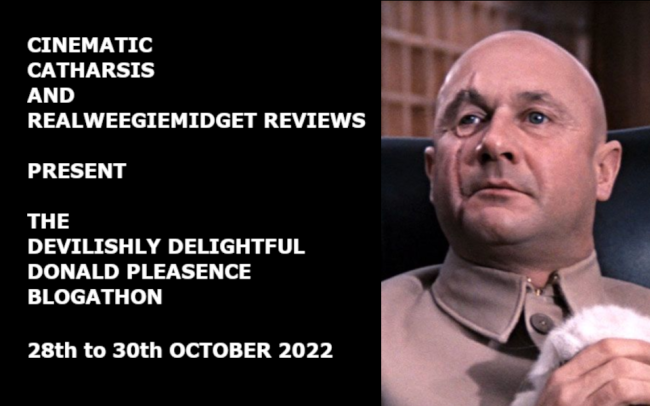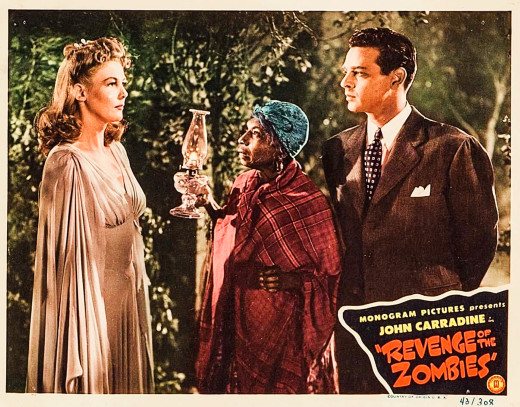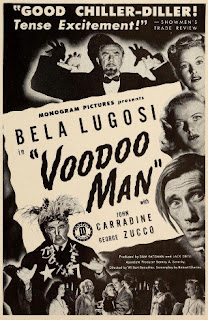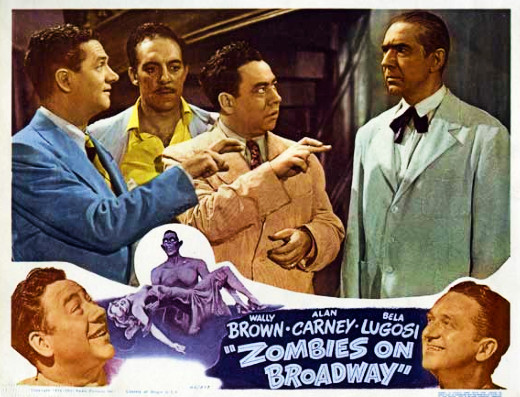Happy Halloween from the house where Films From Beyond dwells!
October 31, 2022
October 28, 2022
Who's minding the asylum?: Alone in the Dark
Pros: Great cast led by Donald Pleasence, Jack Palance and Martin Landau; Good building of tension; Lots of sly black humor
Cons: Casting two familiar actors in the maniac roles somewhat undermines the characters’ menace
Even though the end of October is my busiest time during my favorite season, when I saw that fellow bloggers Gill from Realweegiemidget Reviews and Barry from Cinematic Catharsis were hosting a Donald Pleasence blogathon, I couldn’t turn down the opportunity.
I first encountered Mr. Pleasence when my parents took me to see The Great Escape at the fancy cinema in the big city. In this great WWII epic set in a German prisoner of war camp, Pleasence plays Blythe, an unassuming little man that no one would look twice at -- except that he is a master forger, and the men planning their escape from the camp need his help creating ID papers. Ironically, he was very prepared for the role. During the war Pleasence was a crew member on an RAF bomber that was shot down over France, and he spent time in just such a camp.
For my next encounter, I stood in a long line at the local downtown theater to see You Only Live Twice (naturally, this was before the era of multiplexes). Pleasence’s turn as the Bond super villain Blofeld is memorable. Blofeld, his face hidden behind a screen, strokes his beautiful Persian cat as he orders his minions around in a quest for world domination. Later on, the reveal of his scarred face is worthy of a horror film, and You Only Live Twice immediately became my new favorite movie (not that I needed any excuse to like James Bond movies at that age).
Somehow, this diminutive, soft-spoken, professorial-looking man could play the most endearing, gentle person in one film and then make your blood run cold the next. Speaking of blood running cold, while Pleasence was by no means a horror specialist, he made his fair share of horror films, enough for at least a couple of Halloween film festivals.
 |
| Blofeld suddenly realized that in his haste to blackmail world leaders, he forgot to pick up more kitty litter. |
One of his earliest and best horror roles was as the slimy Mr. Hare in The Flesh and the Fiends (1960), the creepiest retelling of the infamous Burke and Hare story that you’ve never heard of (see my review here). In the early ‘60s, guest shots on such spooky TV series as One Step Beyond, The Twilight Zone and The Outer Limits indicated his potential for creepy roles.
By the early ‘70s, the horror roles became more numerous. Pleasence played an inspector in the claustrophobic cult horror Death Line (aka Raw Meat, 1972), then a mad doctor in The Freakmakers (aka The Mutations, 1974). Along the way were memorable appearances in the anthology fright fests Tales that Witness Madness (1973) and From Beyond the Grave (1974). Whether he was playing good guys or villains, he always lent an aura of class to these low-budget films.
Pleasence is perhaps best remembered for his role as Dr. Loomis, Michael Myer’s attending psychiatrist and grim adversary in the Halloween film franchise. Although horror movies traditionally have portrayed psychiatrists as hopelessly naïve and easily duped by the depraved psychopaths they’re treating, Loomis is famously clear-eyed and adamant in the original Halloween: “I spent eight years trying to reach him, and then another seven trying to keep him locked up, because I realized that what was living behind that boy's eyes was purely and simply... evil.”
A few years after uttering that severe judgment, Pleasence would play yet another psychiatrist in a horror film, only this time his character, Dr. Leo Bain, would be the complete opposite of Loomis -- idealistic and naïve to a deadly fault.
Like many slasher films, Alone in the Dark (1982) operates in a Dirty Harry kind of world where do-gooders who believe criminals can be reformed and lunatics can be cured (or at least controlled) are setting themselves up to be lambs to the slaughter.
The slaughterers in this case are a quartet of psychos who occupy the third floor of an institution run by Dr. Bain. Bain doesn’t like the loaded term “asylum,” preferring to call his institution “The Haven.”
 |
| The New Age psychiatrist in his natural habitat. |
Bain’s Haven is home to all kinds of crazies, er, um ill people, but the boys on the third floor are psychopaths with a history of murder and mayhem. “Fatty” Elster (Erland van Lidth) is an obese child molester. John “The Bleeder” Skaggs (Phillip Clark), who doesn’t like to show his face, is a strangler who gets severe nosebleeds when he kills. Byron “Preacher” Sutcliff (Martin Landau) is a former minister who believes he’s on a mission from God, and has a tendency to burn down churches with people inside them. The leader of the group, Hawkes (Jack Palance), is a grizzled war veteran with a severe case of homicidal post-traumatic stress disorder.
As Bain is giving a tour to his newest staff doctor, Dan Potter (Dwight Schultz), he explains that the state authorities were at first nervous about Bain keeping these dangerous inmates, but let it go when he installed electric sensor-operated steel shutters that allow the men to roam the floor, but are activated if they try to leave their confines. Later, the third floor orderly Ray Curtis (Brent Jennings) confides to Potter that all that separates him (and the outside world) from these men is electricity. He also warns the new doctor that Hawkes is convinced that Potter killed his predecessor, Dr. Merton, who left The Haven to take another position.
Potter brushes off Curtis’ warning about Hawkes, chalking it up to a typical inmate’s delusion. But, unlike the smugly confident Dr. Potter, we know just where this is heading -- the power is going to go off, the third floor inmates will escape, and there will be hell to pay.
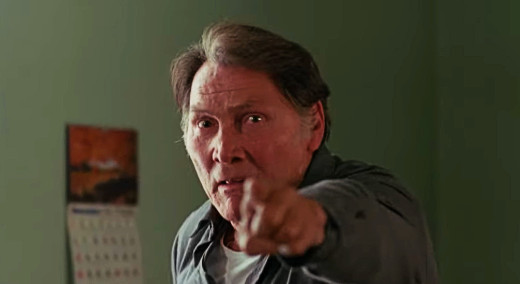 |
| "DR. POTTER!! ... Happy...trails..." |
Coming out in 1982, Alone in the Dark rode the wave of slasher films that followed in the wake of the surprise hits Halloween (1978) and Friday the 13th (1980). Slashers seemed like a natural fit for a Zeitgeist molded by Vietnam, Watergate, oil shortages, stagflation and rising crime, where trust in authorities and a society that could keep us safe and secure was at an all-time low. Slasher films taught us that no place was safe, not small towns, big cities, summer camps, sorority houses… zip, zero, zilch. Even Reagan’s “Morning in America” couldn’t tamp down these exceedingly dark films.
Alone in the Dark is a classic artifact of its time, and a relentless indictment of it: authorities are incompetent and clueless, and society is just one power blackout away from savage chaos.
Exhibit #1 in the list of indictments is Dr. Bain. Bain is the ultimate touchy-feely, new-agey intellectual who doesn’t seem to be living on the same planet as the rest of humanity. He tells Potter that the Haven’s inmates aren’t patients, but rather “voyagers taking a journey into the innermost reaches of the psyche.”
Bain values the voyagers’ welfare to the point that he is oblivious to the dangers they pose to the outside world. He indulges the firebug “Preacher” by giving him matches, which the man promptly uses to light his coat on fire and swing it wildly around.
Later, after Hawkes & crew have made their escape and are racking up a body count, Bain frets that the men are “still disturbed by their escape,” and their violence is “a cry of pain.” In another bit of black humor, Bain tries to phone Potter’s home, but the line has been cut. He argues with the operator, who can’t convince him the line is out. When she ends the call with a sarcastic remark, Bain mutters to himself “Now she’s got a serious problem!” In playing the part absolutely straight, Pleasence manages to elicit a bit of sympathy for a character that is otherwise dangerously out-of-touch.
More deserving of sympathy is Dr. Potter, whose decision to take a new job at the Haven turns out to be the worst of his life. Moving your family to a new place is hard enough without the homicidal inmates at your new workplace deciding that you’ve killed their beloved doctor, and then being set free by a freak power blackout to stalk you and your loved ones.
 |
| Bain and Potter discuss the wisdom of giving matches to pyromaniacs. |
Even before that particular sh*t hits the fan, Potter is stressed after his tour of the facilities and observance of Dr. Bain’s decidedly unique methods for handling the residents. His wife Nell (Deborah Hedwall) is skeptical, flippantly asking “Why can’t you just get an office and treat neurotics like a normal person?”
To add insult to injury, Potter's neurotic, needy sister Toni (Lee Taylor-Allen) is visiting for the week, and, dressed in a punk outfit and pink hair, she insists on dragging her brother and sister-in-law to a punk rock concert headlined by The Sick F*cks (a real band, it turns out). The only member of the family who seems unaffected by all the turmoil is the Potter’s young daughter Lyla (Elizabeth Ward), who calls her parents by their first names and has the grating self-confidence of a precocious pre-teen.
It’s while the group is at the concert that the power goes out. Potter is grateful for the reprieve from the musical stylings of the Sick F*cks, but little does he know that the outage has set in motion a chain of events that will end up with he and his family holed up in their house, trying to dodge crossbow arrows and hunting knife blades wielded by another band of truly sick f*cks.
Living in our current age of anxiety, it’s easy to forget that there have been other periods when popular opinion held that we were well and truly screwed. In addition to Dr. Bain’s questionable authority -- it’s tempting to think that he’s not a real doctor, but one of the inmates running the asylum -- Alone in the Dark depicts a world that is ready to crumble into chaos at a moment’s notice.
The blackout turns the quiet little town into a seething mass of rioters and looters. When Hawkes and his band arrive in town in their stolen car, they’re completely in their element. Hawkes looks around at the cars on fire and the broken store windows and beams with satisfaction, like a victorious general surveying the battlefield. As the inmates join a crowd of looters at the sporting goods store and help themselves to all kinds of knives and weapons, they’re barely noticed in all the confusion.
 |
| The boys help themselves to sale items at the local sporting goods store. |
It’s probably no coincidence that the two most colorful Haven escapees are an ex-military man and an ex-preacher. Along with Bain representing medical science, Hawkes and Sutcliff are highly dubious representatives of their respective institutions. Alone in the Dark suggests that not only are the inmates running the asylum, they’re threatening to run the whole world.
But Bain, Hawkes and Sutcliff aren’t the film’s only digs at contemporary society. At one point, as the Potters are trying to deal with the consequences of the blackout, an announcer on the radio playing in the background reads a press release from the local nuclear power station denying any responsibility for the power outage (corporate speak for “we’re as guilty as hell, but just try to prove it!”). That's Toni's cue to be “helpful” once again and drag sister-in-law Nell to a huge protest at the plant.
She only manages to get Nell and herself jailed for disturbing the peace. And through parental miscommunication, Lyla is home alone. Uh-oh!
Alone in the Dark does a masterful job of ratcheting up the tension, slowly at first, with the “something’s not quite right here” tour of The Haven, to the maniacs casing the Potter’s home (the Preacher pretends to be a telegram messenger, and Fatty poses as Lyla’s babysitter), to the all-out assault on the family at the climax.
 |
| The boys enjoy a ride around town. |
Along the way, in addition to the sly commentary, it also has fun with slasher tropes (or should I say, plot elements that were soon to become tropes in the ‘80s). There’s the classic clueless babysitter who, after making sure the kid is asleep, invites her boyfriend over to fool around. The writers set up a clever bit of misdirection when she hears strange sounds, and insists that the boyfriend check out the bedroom closet.
The stellar, high-profile cast, especially Jack Palance and Martin Landau, is the film’s biggest asset and at the same time its biggest weakness. Palance, no matter the role, always looked like he was ready to explode at any moment, and is a perfect fit for the hand-grenade-without-a-pin that is Hawkes. And when Landau breaks into his wide-eyed, evil-Joker smile, he sends chills up the spine.
But the atmosphere of dread that Alone in the Dark takes pains to cultivate is undercut by making the characters a little too familiar, what with their background stories and recognizable faces. By contrast, the unseen killer in the original Friday the 13th is a complete surprise at the end, and Halloween’s Michael Myers is an evil enigma, a “shape” behind a rubber mask.
This was not the only horror film Palance and Landau would make together. A couple of years earlier, the two appeared in Without Warning (1980), a low-budget sci-fi/horror film featuring a Predator-like alien hunting humans in the woods.
 |
| "Heeeerrrrrrrrrrre's Byron!" |
Both would go on to score dark horse supporting actor Oscar wins, Palance for City Slickers (1991) and Martin Landau for Ed Wood (1994). And of course, Donald Pleasence would become a fixture as Loomis in one of the most successful horror film franchises of all time.
Alone in the Dark was writer-director Jack Sholder’s first feature, and it’s quite a debut. In the next few years he made two more minor cult favorites, A Nightmare on Elm Street 2: Freddy’s Revenge (1985) and The Hidden (1987), then settled into directing TV movies and episodes.
When I found out about the blogathon and was perusing Donald Pleasence’s IMDb resume for a good Halloween choice (excluding the Halloween movies, which others have written about extensively), Alone in the Dark jumped out at me because I had no recollection of ever seeing it or even reading about it. I’m not a big fan of slasher movies, but I’m at least aware of the classics and some of the also-rans in the genre, so stumbling across an unknown (to me) horror film starring not only Donald, but Jack and Martin as well was a Pleasence surprise (sorry, I couldn't help myself).
Usually in these cases, the reason I’ve never heard of a film is because it’s so bad even bad movie lovers have steered clear over the years. Since Alone in the Dark is very good, it remains a mystery how it evaded my attention all this time. Thanks to Gill and Barry and their Devilishly Delightful Donald Pleasence blogathon for indirectly steering me to this great find!
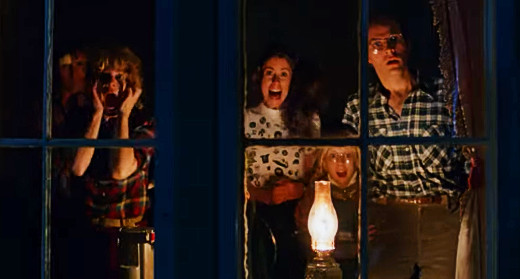 |
| Alone in the Dark is a good reminder that it pays to be prepared for emergencies like power blackouts and/or homicidal maniacs invading your home. |
Where to find it: DVD/Blu-ray | Streaming
October 14, 2022
Zombie Dearest: A Selective Look at Pre-Romero Zombie Movies
I’ve said it on this blog before and I’ll say it again: I’m not a big fan of the endless hordes of plague-spawned zombies that have shambled their way across movie and TV screens ever since George Romero’s Night of the Living Dead opened up the flood gates. For me, modern zombies are too abstract a threat, too numerous, and too interchangeable to be all that interesting after you’ve seen a handful of these shows.
I get it that apocalyptic zombies are just there to get the survivalist drama going, whereby we learn something about ourselves -- the good, the bad and ugly -- through characters desperately trying to get by in a desolate and dangerous world. But for me, the relentless survivalist thing with hardly a glimmer of hope gets awfully old awfully fast.
In contrast to the bleakness of a zombified world, I prefer my horrors to be more up close and personal and not quite so earth shattering. With more traditional horror, you can have your monsters and beat them too. When it comes to creating zombies, Voodoo practitioners and mad doctors are a lot more tangible and colorful than viruses or experimental gasses. And they make great foils in the eternal struggle of good vs. evil -- defeating a living, breathing mad person is so much more satisfying.
Zombies in the Great Depression
Voodoo-style zombies got their start in Hollywood around the same time that Dracula and Frankenstein debuted for Universal Pictures. In fact, it was Dracula himself, Bela Lugosi, as the enigmatic and aptly named “Murder” Legendre, who conjured up the first cinematic zombies in White Zombie (1932).Legendre is the sinister foreman on a Haitian plantation owned by Charles Beaumont (Robert Frazer). Legendre is worth his weight in gold to Beaumont, as he is able to create zombies out of the local population who are absolutely obedient and work for nothing (Jeff Bezos, take note). When Beaumont meets Neil and Madeline (John Harron and Madge Bellamy), an attractive young couple who are engaged to be married, he invites them to stay at his mansion and have the ceremony there.
Of course, the creepy old rich guy has designs on the beautiful girl, and he has his Voodoo-master henchman Legendre turn Madeline into a zombie so that he can have her for himself. Beaumont quickly realizes his mistake, as zombies are not exactly the life of the party, and orders Legendre to restore Madeline to life. When Legendre refuses, it becomes apparent who really runs the show (hint: it’s the guy with the platoon of zombies under his control). Legendre seems to be riding high, but Neil and a local missionary, Dr. Bruner (Joseph Cawthorn), may have something to say about that.
Although not well-received at the time, over the years White Zombie’s reputation has returned from the dead to be regarded as an example of the triumph of creepy atmosphere and moody black and white cinematography over stilted acting. According to Bela Jr., the film was a personal favorite of his father’s. But it was also an early indicator of bad career decisions that would haunt Lugosi throughout his life -- for years afterward he regretted taking a paltry sum upfront instead of a cut of the robust box office receipts.
 |
| "Stick with me kid and you'll go places!" |
Zombies go to war
While it was no Night of the Living Dead, White Zombie inspired more than a few imitators. Next out of the gate was Revolt of the Zombies (1936), which was not so much an imitation as a follow-up to White Zombie made by the same producers and director. Set shortly after World War I, Revolt switches locales from Haiti to the exotic temples of Cambodia, where an expedition sent by the Allied Command is rummaging around, looking for the arcane “Secret of the Zombies” (shades of Indiana Jones and the Raiders of the Lost Ark!).
One of the eggheads attached to the expedition, Armand (Dean Jagger), stumbles upon the secret of making zombies, and uses his newfound power to intimidate the only female member of the group, Claire Duval (Dorothy Stone), who loves another.
The outbreak of World War II couldn’t stop the advance of zombies in the B movie units of Hollywood. Initially, the movie villains exploiting zombies shifted from evil plantation owners and Voodoo followers to Nazi operatives using their arcane knowledge to subvert the allied cause.
Monogram Pictures, King of the “Poverty Row” studios specializing in B programmers, made near-identical twin zombie pictures in the early ‘40s. King of the Zombies (1941) and Revenge of the Zombies (1943) share so many plot points and themes (and two cast members), that they’re easy to get confused with one another:✔ Both feature suave doctors who turn out to be Nazi spies using Voodoo and zombies to further their sinister aims (Dr. Sangre in King, played by Henry Viktor, and Dr. Von Altermann in Revenge, played by John Carradine).
✔ Both doctors have beautiful wives who walk around in a catatonic state (I’ll leave it to you to guess why).
✔ Instead of just one rock-jawed protagonist, the films opt for a tag-team bro duo who for much of the time are maddeningly clueless to all the creepy stuff happening in front of their noses (Dick Purcell and John Archer in King; Robert Lowery and Mauritz Hugo in Revenge).
✔ Both feature an attractive female second lead for romantic subplot purposes (Sangre’s niece played by Joan Woodbury and Von Altermann’s secretary played by Gale Storm).
✔ Both Doctors’ households are run by Madame Sul-Te-Wan, who, according to IMBDb, was the first African-American actress to secure a contract with a major studio.
✔ And then there is the dubious comic relief of bug-eyed Manton Moreland, who plays a superstitious valet in both. Monogram could still get away with such stereotyped characters in the ‘40s. Manton’s routines were so popular that he was a regular go-to character actor for the studio, appearing in a recurring role in their Charlie Chan series (and often getting favorable billing). Even though Moreland jumps at every shadow that crosses his path, to be fair, he is far more perceptive than his obtuse bosses, who couldn’t sense danger if it walked up and slapped ‘em silly.The biggest distinction between the two films, such as it is, is the scope of the villains’ ambitions. In King, Sangre, partnering with the Voodoo priestess played by Madame Sul-Te-Wan, attempts Voodoo soul transference (!?) on a Navy admiral he has captured in order to extract defense secrets. (This being 1941, shortly before the U.S. entered the war, the government Sangre is working for is unnamed...wink, wink.)
A couple of years later, with the U.S. fully immersed in the fight against the Germans and Japanese, Revenge ups the ante considerably, making Von Altermann into a mad Nazi doctor intent on creating an army of zombies to turn the tide of the war.
Will the dense protagonists get wise in time to foil the nefarious plots? Will the more handsome of the pair get the girl? Will Manton Moreland’s belief in zombies be vindicated? Take a wild guess.
War-weary zombies
As the global conflict ground on, movie-makers scaled back the war themes in their B programmers in deference to audiences who simply wanted to forget their troubles for a couple of hours at the theater.
Auteur B movie producer Val Lewton wisely set his 1943 film I Walked with a Zombie on a fictional Caribbean island, and borrowed liberally from Charlotte Brontë’s Jane Eyre in telling the atmospheric tale of a young nurse (Frances Dee), who begins to believe that the expressionless, sleep-walking wife of her wealthy employer (Tom Conway) is really a zombie.
Lewton carries on the tradition of having a beautiful wife under a zombie spell, but also includes one of the creepiest male zombies ever for good measure. And thankfully, there’s not a whiff of war or spies or mad Nazi doctors.
 |
| Darby Jones' zombie scared the snot of me when I first saw I Walked with a Zombie. |
Lewton’s film is dark, moody, beautifully photographed, and includes some genuinely suspenseful moments. On the other end of the scale is producer Sam Katzman’s Voodoo Man (1944), which is as gloriously cheesy as Lewton’s film is somber and serious.
Voodoo Man has the distinction of being the first self-aware, meta-zombie movie in Hollywood history. Tod Andrews plays Ralph Dawson, a screenwriter working for Banner Pictures (the actual name of Katzman’s production company). The studio boss S.K. (uh-huh) summons Ralph to his office to assign him a horror script based on a ripped-from-the-headlines story of women who have mysteriously gone missing in the area. Ralph reminds him that he’s taking time off to get married and go on his honeymoon.
The hapless scenarist runs out of gas on the way to his fianceé’s house, and by chance is picked up by Sally (Louise Curry), who just happens to be the maid of honor and is headed to the house as well.
After they turn off on a detour in the middle of nowhere, Sally’s car dies. Ralph spots a nearby mansion, but is rebuffed at the door by a servant. When he gets back to the car, Sally is nowhere to be found. It seems that Ralph has stumbled into the missing girl mystery that S.K. wanted him to exploit.
At the center of the conspiracy is Dr. Richard Marlowe (Bela Lugosi), whose beautiful wife (Ellen Hall) is dead, but still able to walk around (you didn’t think they’d leave out the beautiful zombified wife, did you?). He needs healthy young women in order to transfer their life essences to his wife and restore her to the living. Marlowe is aided in his mad plan by Nicholas (George Zucco), the local gas station owner and Voodoo witch doctor (now there’s a unique skill set!), who identifies likely candidates and officiates at the transference ceremonies. John Carradine is on hand as half of a duo of mentally-challenged henchmen who do the actual kidnapping (a big comedown from his stint as the Nazi doctor in Revenge).
The ceremony is a marvel of B movie cheese, and it alone is worth looking up Voodoo Man. As master of ceremonies, the normally professorial-looking Zucco sports a feathered headdress, facial paint and a classic magician’s robe with stars and crosses. His dignity takes a further hit when he’s given lines like: “Ramboona is all powerful!” (All powerful, yes, but apparently Ramboona helps those who help themselves to unwary young women.)
Lugosi’s outfit is more restrained, but he gets the best lines of all as he facilitates the soul/life force transference. He summons up his best halting Dracula voice as he intones over and over, “Mind…to…mind, soul from body…to…body, emotion…to…emotion, life…to…death…” In the background, John Carradine's idiot henchman bangs on bongo drums (!?) with a vacant, almost zombie-like look on his face.
There’s not a chance of suspense in something this silly, but there is one notable scene in which Carradine releases several young women, the product of previous failed experiments, from their cells in the basement. Dressed in their long-flowing ceremonial robes and staring ahead, lifeless, yet still ambulatory, they’re reminiscent of Dracula’s brides.
The self-awareness comes full circle at the end, when Dawson delivers a script titled "Voodoo Man" based on his experiences, and he suggests to S.K. that Bela Lugosi play the lead (cue the laugh track).
Years later, Sam Katzman would try his hand with yet another zombie movie, The Zombies of Mora Tau (1957). That one is about a group of zombie sailors guarding a sunken treasure. Despite the unique nautical angle, Mora Tau is deadly dull compared to the madcap antics of Voodoo Man.
Zombies in the big city
In an era of total war, traditional movie monsters seemed lame and innocuous in comparison. So B movie makers embraced the lameness by increasingly mixing broad comedy with horror, often bringing together established comedic teams with horror icons. The result was pictures like Spooks Run Wild (1941) and Ghosts on the Loose (1943), in which Bela Lugosi serves as a foil for the comic pranks of the East Side Kids.
Several years before Universal decided to team up their stable of classic monsters with Abbott and Costello, RKO Radio Pictures jumped on the bandwagon by making a sort of sequel to the classic I Walked with a Zombie -- only this time featuring their own comic duo.In Zombies on Broadway, two inept press agents, Jerry Miles and Walt Strager (Wally Brown and Alan Carney) are ordered by their gangster boss (Sheldon Leonard) to find a real living-dead zombie to appear at the opening of his new night club, The Zombie Hut. They travel to the Caribbean island of San Sebastian (the same fictional locale as the Lewton film), where a certain Dr. Renault (Bela Lugosi) has supposedly become an expert in creating zombies.
Needing help to find the elusive doctor, the boys team up with a beautiful nightclub singer, Jean La Dance (Anne Jeffreys), who in exchange wants a ride back to New York. Plans go awry when Jean is kidnapped by one of Renault’s zombies (Darby Jones, in the identical make-up he wore in I Walked with a Zombie), and Walt is zombified (but only temporarily) by the mad doctor.
By this point Lugosi, whose glory days were far behind him, was used to being upstaged by low-rent comedy acts in horror cheapies that exploited his name recognition. But just a few years later, Lugosi would have the last laugh (and the last big boost of his career) with yet another horror comedy, reprising his cherished Dracula role to wide acclaim in Universal’s Abbott and Costello Meet Frankenstein (1948). RKO, in recycling characters and locales from I Walked with a Zombie and bringing in Lugosi to share in the fun, provided a sort of dress rehearsal for Bela’s last big break at Universal.
Epilogue
As the Atomic Age dawned and the Cold War set in, supernatural zombies shuffled off the stage to make way for irradiated giant monsters and alien invaders. But you can’t keep the living dead down for long. Inevitably, zombies made a spectacular comeback via the imagination of an unassuming low-budget filmmaker named George Romero, and they’ve been overwhelming the earth ever since, powered by strange viruses instead of Voodoo.
Romero could scarcely imagine the endless zombie plagues that would be unleashed by Night of the Living Dead. But the old-time zombies are still around, waiting patiently on DVD and streaming sites for that special, nostalgic viewer to summon them.







